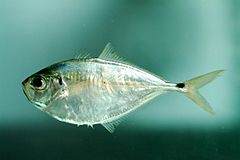- Atlantic bumper
-
Atlantic bumper 
Scientific classification Kingdom: Animalia Phylum: Chordata Class: Actinopterygii Order: Perciformes Family: Carangidae Genus: Chloroscombrus Species: C. chrysurus Binomial name Chloroscombrus chrysurus
(Linnaeus, 1766)The Atlantic bumper, Chloroscombrus chrysurus, is a game fish in the family, Carangidae. It was first described by the "father of modern taxonomy", Carl Linnaeus in the book, Systema Naturae. Atlantic bumper are known to eat smaller fish, cephalopods, and zooplankton.[1]
Contents
Description
The Atlantic bumper is best recognized by its profile, the bottom being much more curved than the top.[2] Also, the lateral line is arched near the head.[2] Atlantic bumper are generally described as silver to golden colored, with golden yellow on the anal and caudal fins,[3] which have 3 spines, 25-28 rays and 9 spines, 25-28 rays, respectively.[2] There is an obvious black saddle-shaped blotch on the caudal peduncle and a similar patch near the edge of the opercle.[3]
Although the average size of Atlantic bumper is 25 cm,[4] the largest recorded Atlantic bumper was 65 cm long.[5]
Distribution and habitat
In the western Atlantic, Atlantic bumper is found from Massachusetts, south to Florida.[2] They are known to be found off Bermuda, in the Caribbean, and the Gulf of Mexico.[6] Their range continues south to the coast of Uruguay.[7] In the eastern Atlantic, the Atlantic bumper are known from the coast of Mauritania to Angola.[2] They are not found in the eastern Pacific because they replaced by another species, Chloroscombrus orqueta, or the Pacific bumper. However little is known about how these two species relate to each other, and they may represent only one species.[2]
The Atlantic bumper is found in subtropical waters up to 55 m in depth.[2] They usually dwell near soft bottoms of the continental shelf, but have been observed schooling near the surface.[8] While it is primarily a salt water fish, juveniles have been found in brackish estuaries.[8]
References
- ^ Diouf, P.S., 1996. Les peuplements de poissons des milieux estuariens de l'Afrique de l'Ouest: L'exemple de l'estuaire hyperhalin du Sine-Saloum. Université de Montpellier II. Thèses et Documents Microfiches No.156. ORSTOM, Paris. 267 p.
- ^ a b c d e f g "Fishbase.org entry on Atlantic bumper". http://www.fishbase.org/Summary/SpeciesSummary.php?id=385. Retrieved 2008-05-14.
- ^ a b "Research.myfwc.com entry on Atlantic bumper". http://research.myfwc.com/gallery/image_details.asp?id=14507. Retrieved 2008-05-14.
- ^ "zipcodezoo.com entry on Atlantic bumper". Archived from the original on 2008-05-07. http://web.archive.org/web/20080507121956/http://zipcodezoo.com/Animals/C/Chloroscombrus_chrysurus.asp. Retrieved 2008-05-15.
- ^ Daget, J. and W.F. Smith-Vaniz, 1986. Carangidae. p. 308-322. In J. Daget, J.-P. Gosse and D.F.E. Thys van den Audenaerde (eds.) Check-list of the freshwater fishes of Africa (CLOFFA). ISNB, Brussels; MRAC, Tervuren; and ORSTOM, Paris. Vol. 2.
- ^ Cervigón, F., 1993. Los peces marinos de Venezuela. Volume 2. Fundación Científica Los Roques, Caracas, Venezuela. 497 p.
- ^ Smith, C.L., 1997. National Audubon Society field guide to tropical marine fishes of the Caribbean, the Gulf of Mexico, Florida, the Bahamas, and Bermuda. Alfred A. Knopf, Inc., New York. 720 p.
- ^ a b Cervigón, F., R. Cipriani, W. Fischer, L. Garibaldi, M. Hendrickx, A.J. Lemus, R. Márquez, J.M. Poutiers, G. Robaina and B. Rodriguez, 1992. Fichas FAO de identificación de especies para los fines de la pesca. Guía de campo de las especies comerciales marinas y de aquas salobres de la costa septentrional de Sur América. FAO, Rome. 513 p. Preparado con el financiamento de la Comisión de Comunidades Europeas y de NORAD.
External links
Categories:
Wikimedia Foundation. 2010.
